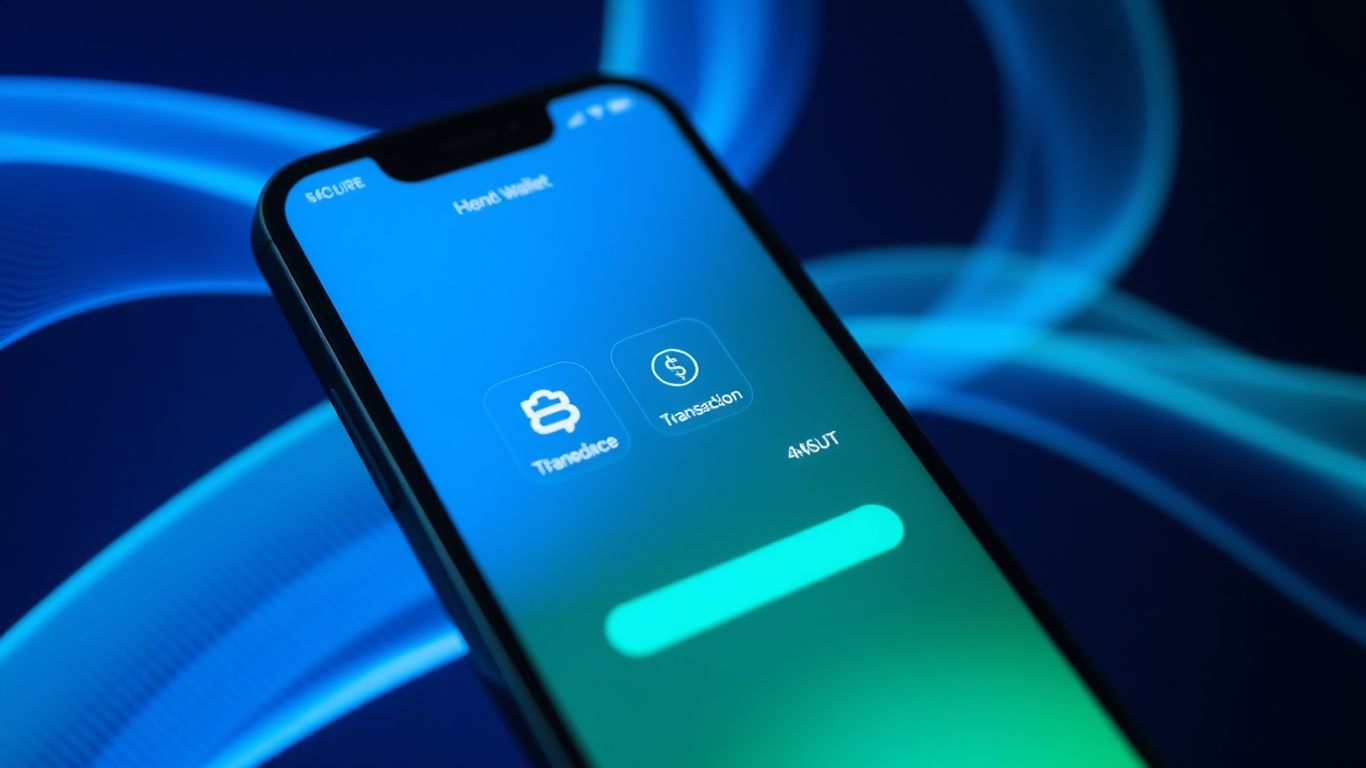[ newsletter ]
Stay ahead of Web3 threats—subscribe to our newsletter for the latest in blockchain security insights and updates.
Thank you! Your submission has been received!
Oops! Something went wrong. Please try again.
Master e wallet app development in 2025 with our comprehensive guide. Learn about security, features, and launching your app.





Thinking about building your own digital wallet app? It’s a smart move, with mobile payments getting bigger every year. We're talking about a huge market, and getting your app right from the start is key. This guide is here to walk you through what you need to know for 2025, covering everything from planning and security to the features that’ll make users stick around. Let's get your e wallet app development journey started.

So, you're thinking about building an e-wallet app for 2025? Smart move. It's not just a trend anymore; it's pretty much a necessity if you want to keep up in the world of digital payments. Think about it – people are using their phones for everything, and handing over cash or even digging out a card feels like a hassle. E-wallets just make things so much simpler. This shift means that developing a solid e-wallet app is key for any business wanting to stay relevant and grab a piece of a massive, growing market.
The numbers here are pretty wild. We're talking about a market that's already huge and just keeps getting bigger. It's not just about sending money to friends anymore; it's about everyday purchases, online shopping, and even managing loyalty cards. The growth projections show that this isn't a fad; it's the future of how we handle money.
This kind of expansion means there's a lot of opportunity, but also a lot of competition. You need to make sure your app stands out.
What actually goes into making an e-wallet app work? It's more than just a place to store card details. You've got the basics, of course, but then there are the things that make it secure and easy to use. Think about it like building a house – you need a strong foundation, walls, and a roof, but then you add the plumbing, electricity, and nice finishes.
Here are some of the main bits:
Building a successful e-wallet app in today's market requires a deep understanding of user needs and the technological capabilities available. It's about creating a secure, convenient, and feature-rich experience that users will want to come back to again and again.

Getting an e-wallet app off the ground isn't just about coding; it's about smart planning from the get-go. You've got to figure out what you're actually building and why, pick the right tools for the job, and have a realistic idea of the costs involved. Skipping these steps is like trying to build a house without a blueprint – messy and likely to fall apart.
First things first, what exactly do you want this e-wallet to do? Is it a simple peer-to-peer money transfer app, or are you aiming for something more complex like a crypto wallet or a retail-focused app with loyalty programs built-in? Your core goal will shape everything else. Think about who you're building this for – what are their needs? What problem are you solving for them?
Clearly defining your scope early on can prevent a lot of headaches down the road. It helps keep the project focused and stops it from ballooning into something unmanageable and way over budget. It’s about being intentional with every feature you decide to include.
Once you know what you're building, you need to decide what tools you'll use to build it. This is your tech stack. For an e-wallet, speed and security are super important, so you'll want technologies that can handle that. If you're building for both Apple and Android, you might consider cross-platform tools to save time and money. If you're dealing with complex financial transactions or blockchain, you'll need specific frameworks for that.
Here's a quick look at some common considerations:
The wrong tech stack can slow down your app and make it harder to scale later on.
Let's talk money. Developing an e-wallet isn't cheap, and costs can vary wildly depending on the features, complexity, and the team you hire. A basic app might cost tens of thousands, while a feature-rich one could easily run into hundreds of thousands. It's important to be realistic.
Here’s a rough breakdown of where your budget might go:
Consider starting with a Minimum Viable Product (MVP). This means building only the core features needed to launch and get user feedback. You can always add more features later once you know what users actually want and are willing to pay for. This approach can significantly cut down initial development costs and get your app to market faster.
When you're building an e-wallet app, security and following the rules aren't just afterthoughts; they're the bedrock. Think of it like building a house – you wouldn't skimp on the foundation, right? The same goes for digital money. People are trusting you with their hard-earned cash and personal details, so keeping that safe and sound is job number one.
Data breaches are a huge headache, and in the finance world, they can be devastating. We're talking about sensitive customer info, transaction histories, and all sorts of private data. If that gets out, not only do you face massive financial penalties, but your reputation takes a nosedive. It's a tough spot to be in. To keep things locked down, you need a multi-layered approach. This means using strong encryption for data both when it's moving and when it's stored. Tokenization is another smart move, where sensitive data is replaced with a unique token, making it useless to hackers even if they get their hands on it. Regular security audits are also a must, like having a security guard constantly patrol your digital premises, looking for any weak spots before someone else does.
Navigating the world of financial regulations can feel like a maze. Different countries and regions have their own sets of rules, like PCI-DSS for payment card data or GDPR for user privacy in Europe. Ignoring these isn't an option. Non-compliance can lead to hefty fines – we're talking potentially tens of thousands of dollars or more – and a serious blow to customer trust. It's not just about avoiding penalties, though. Following the rules shows your users that you're a legitimate and trustworthy operation. Setting up clear processes for things like Know Your Customer (KYC) verification is key here. This helps confirm user identities and keeps the platform clean from fraudulent activity.
Getting users into their accounts securely is a big deal. Simple passwords just don't cut it anymore. You need strong authentication methods. Biometrics, like fingerprint or facial recognition, offer a convenient yet secure way for users to log in. Two-factor authentication (2FA) adds an extra layer of protection, requiring users to provide two different forms of verification before granting access. Think of it as needing two keys to open a vault. On the encryption front, using industry-standard protocols like TLS/SSL for data in transit and strong encryption algorithms for data at rest is non-negotiable. This ensures that even if data is intercepted, it remains unreadable to unauthorized parties.
Getting users signed up and verified needs to be smooth. Nobody wants to spend ages filling out forms or jumping through hoops just to start using a new app. A good digital wallet app makes this part quick and easy. Think about letting people sign up with just their phone number or email, and then guiding them through the identity checks without making it feel like a chore. This often involves uploading a photo of their ID and maybe a quick selfie. It's all about building trust right from the start and making sure you're following the rules about who is using your service.
The first impression really matters. If the signup process is clunky, people will just leave and find another app that's easier to use. It's that simple.
This is the heart of any e-wallet. Users need to be able to do two main things without any fuss: send money and receive money. This includes sending funds to friends and family (peer-to-peer transfers) and paying for things online or in stores. For payments, offering options like QR code scanning or NFC (tap-to-pay) is pretty standard now. People expect to be able to add money to their wallet easily, too, whether that's through a linked bank account or a debit/credit card. And just as importantly, they need to be able to take money out when they want to.
Beyond just moving money around, what makes a wallet app really stand out? It's the little extras that make life easier for the user. Things like keeping a clear record of all transactions, so people can see where their money went. Push notifications are also a big deal – letting users know immediately when a transaction happens or if there's a security alert. Some apps even offer budgeting tools or spending insights, helping users manage their money better. And if something goes wrong, having easy access to customer support, like a chat feature within the app, can make a huge difference in keeping users happy and coming back.
So, you've got your e-wallet app planned out, but how do you make it really stand out in 2025? It's all about using the latest tech to make things smoother and safer for your users. Think of it like upgrading your phone – you want the newest features, right? The same goes for digital wallets.
Artificial intelligence, or AI, is a game-changer for e-wallets. It's not just about fancy algorithms; it's about making the app smarter. AI can look at how people use the app and offer personalized tips, like budgeting advice or spending pattern analysis. Imagine your wallet suggesting where you could cut back based on your habits – pretty neat.
AI is also a big deal for security. It can spot weird activity in real-time, like a transaction that just doesn't fit your usual spending. This helps stop fraud before it even happens. It's like having a super-smart security guard watching over every transaction. This kind of proactive fraud protection is key for building user trust.
Blockchain might sound complicated, but its core idea is simple: a shared, unchangeable record of transactions. For e-wallets, this means a whole new level of security and transparency. Every transaction is recorded on this distributed ledger, making it incredibly hard for anyone to tamper with it. This is a big step up from traditional systems.
Using blockchain can also speed up international transfers and cut down on fees. Plus, it adds an extra layer of trust because everyone can see the record (though personal details are kept private, of course). It's a technology that's really changing how we think about secure digital exchanges.
Remember when passwords were the main way to log in? Those days are fading fast. Biometrics, like fingerprint scans or facial recognition, are becoming the standard for logging into your e-wallet. It's way faster and generally more secure than typing a password that someone could guess or steal.
Here's a quick look at how biometrics work:
These methods make it much harder for unauthorized people to get into an account. Biometric authentication offers a blend of convenience and strong security that users are increasingly expecting. It's about making access quick for you but tough for anyone else. This technology is a big part of the future of digital payments, making transactions feel more natural and protected. You can find more about these innovations in digital wallets here.
The push towards more advanced tech in e-wallets isn't just about keeping up with trends. It's about creating a financial tool that's not only easy to use but also incredibly safe and reliable. Users want to feel confident that their money and personal information are protected, and these technologies are how we get there.
So, you've got this brilliant idea for an e-wallet app. You've planned, you've designed, and you've figured out all the fancy tech. Now comes the part where you actually make it real and get it out there. It’s a big step, for sure, but totally doable if you break it down.
Think of an MVP as your app's starting point. It’s not the whole shebang, but it has just enough features to be useful and to get feedback from actual users. For an e-wallet, this might mean focusing on core functions like making payments and transferring money between users. You skip the bells and whistles for now, like complex budgeting tools or loyalty programs. This approach helps you get to market faster and, importantly, saves a ton of money upfront. You can test your main idea without betting the farm.
Once you have your MVP, or even a more developed version, you absolutely have to test it. Like, really test it. You don't want users finding bugs that cause them to lose money or get locked out of their accounts. This means testing everything: how payments go through, how secure the login is, how the app handles different network conditions, and if it works on various devices. Automated tests are great for catching common issues, but manual testing by real people is also super important.
Testing isn't just about finding bugs; it's about making sure the user experience is smooth and reliable. A glitchy app, no matter how feature-rich, will drive users away faster than you can say "transaction failed."
Getting users to download your app is one thing, but keeping them is another challenge entirely. People are busy, and there are lots of options out there. To keep users coming back, you need to make their experience consistently good. This could involve things like:
Building trust and providing a consistently positive experience are key to long-term user loyalty. It’s about more than just transactions; it’s about building a relationship with your users.
So, we've gone through a lot about making your own digital wallet app. It's not just about making something that handles money; it's about building trust and making things easy for people. Remember to start small with the basics, keep security tight, and always think about what the user actually needs. The mobile payment world is huge and growing fast, so getting this right means you can be a part of it. It takes work, sure, but with the right plan, you can build a wallet that people will actually want to use. Good luck out there!
Think of an e-wallet app like a digital version of your physical wallet, but on your phone! It lets you store your credit cards, debit cards, loyalty cards, and even digital money. You can use it to pay for things online or in stores super quickly and safely, just by tapping your phone.
In today's world, everyone uses their phones for everything, including payments. By having an e-wallet app, businesses can make it easier and faster for customers to pay them. This means more happy customers and potentially more sales because paying is so simple and secure.
The most important stuff includes making it super easy for people to sign up and prove who they are (like showing an ID). Then, you need to let them easily add money and send money to others. And of course, it has to be really, really secure so nobody can steal their money or information.
The cost can change a lot! If you just want the basic features, like sending money, it might cost around $10,000 to $20,000 and take a few months. But if you want lots of fancy features, it can cost much more, maybe up to $300,000 or even higher.
Keeping it safe is a big deal! Developers use special tricks like 'tokenization' to scramble card details, so even if someone got them, they wouldn't be useful. They also use strong codes (encryption) and make sure only the right person can log in, sometimes using your fingerprint or face!
MVP stands for Minimum Viable Product. It means you build the app with only the most important, core features first, like just sending money. This helps you save money and time, and you can get it out to people faster to see what they like before adding more cool stuff later.


